Search Results Full Database
Search criteria: aboriginal artefacts
31 item(s) found:
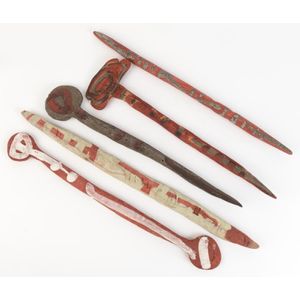
Artist unknown group of five pottery Aboriginal artefacts, monogram mark to one (illegible), the largest 56 cm long

Rare ceremonial post (Walgaroo), Kimberley, Western Australia. Carved and engraved hardwood, European paint and natural pigment. Walgaroo or ceremonial post is kept with a singing stick. Approx length 48.5 cm. Provenance: Private Collection, Queensland. Cf

Six various Aboriginal artefacts. Pair of clap sticks length 29 cm; bullroarer, with incised face decoration and ochre length 28 cm; dance boomerang length 54 cm; barbed spearhead length 46 cm; and hafted axe with stone head length 35 cm.

Two Aboriginal artefacts woomera, carved decoration, 80 cm very finely fluted Coolamon, 58 cm

Rare Gwinjull (singing stick), Kimberley, Western Australia. Carved and engraved hardwood and natural pigment. Provenance: Private Collection, New South Wales. Cf. Page 57, Aboriginal artefacts Tom McCourt. Approx. length 57 x 12 cm

Central Australian Aboriginal artefacts. Including two stone knives, one with detailed label. Also two pyrographed message sticks. Length 19 cm (longest knife)

Large collection north coast aboriginal artefacts, including spear points, the vast majority with place of origin written on including 1 Mile Beach, Stockton Beach, Anna Bay, Treachery Head and others Displayed on glass inside a drawer, this drawer is not

Large quantity of Questa Park aboriginal artefacts, White Cliffs NSW, including spear points and small cutting implements

Two Australian Aboriginal artefacts, including fluted club; woman's club and digging stick; and woomera (spear thrower). David Said Collection, length 71 cm (digging stick)

Shield, Motu people, central Province, Papua New Guinea, 19th century, this type of shield was used along the coast between cape Possession & Hall sound and inland from these coastal areas. These shields are highly sought after by collectors because of the

An early Admiralty Islands Obsidian Bladed spear, together with an Obsidian Bladed dagger, [2], spear with a carved crocodile, ochre painting and fine binding, dagger with tradition resin handle and sharp fine flaked blade. Both late 19th century. Provenan
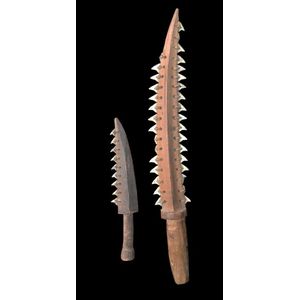
Two fine Gilbert Islands shark teeth knives, 19th century, [2], both carved from hardwood with the original sennit binding holding the serrated shark's teeth in place. A few teeth missing on the larger curved knife, the smaller one in perfect condition. Pr

An old Maori nephrite adze, 19th century or earlier, finely shaped working adze made from a deep green nephrite. Provenance: BL Hornshaw collection (1878-1937) Hornshaw was an avid collector of Pacific & Australian Aboriginal artefacts, he received many of

A fine Taino stone pestle, 1000-1400 AD, Dominican Republic, of dense hard stone carved with a recumbent figure for the handle but the body of the pestle also forms a second figure, minor chips and some white dots of old paint (from when collectors painted

Two fine Fijian pole clubs, 19th century; both with fine incised designs on lower section of the clubs, the butts of both clubs are concave, one pierced for fibre strap and retaining an old collection number 58:297, both with fine old reddish brown patina

Four old Fijian throwing clubs (ula), 19th century; one with extensive vertical notches along shaft. Provenance: Robert Henry Pulleine (1869-1935 ); physician and naturalist, born in New Zealand, spent his childhood in Fiji, the family moved to Adelaide in
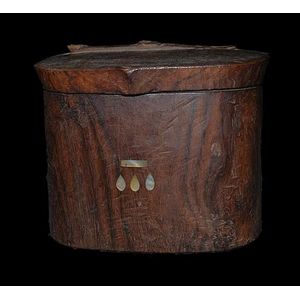
A fishing tackle box, Tokelau (Micronesia), late 19th century; finely carved and with pearl shell inlay design on all four sides. Provenance: B. L. Hornshaw collection (1878-1937) Hornshaw was an avid collector of Pacific and Australian Aboriginal artefact

A ladle, Admiralty Islands, late 19th century; the intricately carved wood handle could be seen as an abstract human figure. Provenance: B. L. Hornshaw collection (1878-1937); Hornshaw was an avid collector of Pacific and Australian Aboriginal artefacts, h

A ritual baton, Malaita Island, Solomon Islands, the wood baton with fine inlay shell work is almost in perfect condition, the neck has a band of small braided sennit fibre. These were called 'Fou atoleleo' in Kwaio Language, they were worn hanging from th

Various strands old shell money, New Guinea, old label reads 'Diuarra shell money New Britain, pres LRH 1910' Provenance: B. L. Hornshaw collection (1878-1937) Hornshaw was an avid collector of Pacific and Australian Aboriginal artefacts, he received many

A very important native rat tooth necklace, old label Reads 'Necklace made from flying fox teeth ( kapoul ) New Guinea 3.8.1925 ' 'The type of teeth are rat, a highly sought after food source in many parts of New Guinea, once I collected similar necklaces
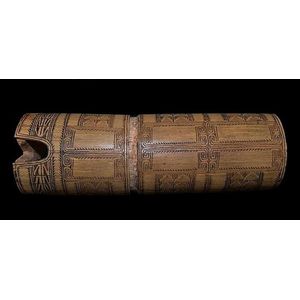
A bamboo lime container, Solomon Islands, late 19th century; carved from two perfect fitting pieces of bamboo, finely incised with bands of designs and traces of black infill, together with a part of a another similar container (top only). Provenance: B. L

Fourteen Kesa shell money, Western Solomon Islands, 18th - 19th century; 'Kesa' is a cylindrical shell wealth that came in different sizes and values. It is old, and is said to have been made by the spirit Pongo. People preserved kesa by wrapping them in i
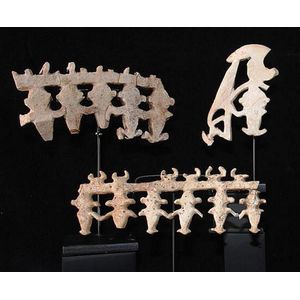
Five ancient Barava ornament pieces, Western Solomon Islands, 18th -19th century; of the old figural type, two on stands. Provenance: Tebbenham collection. Tebbenham was on the Navy Ship the HSM Mohawk 1898 on a punitive expedition to the Western Solomon I

Twenty one pieces cut spiral Conis shells, Western Solomon Islands, 18th - early 19th century; the smallest and slimmest of the shell are 'Hokata' made from onus shells. These were less valuable and used in barter, marital rituals, as small compensation tr

Ten cut spiral conis shells on custom stands, Western Solomon Island, 18th-19th century; the smallest and slimmest of the shell valuables are hokata made from conis shells. These were less valuable and used in barter, marital rituals, as small compensation

Seven ancient Barava ornaments, 19th century or earlier; together with two Kap Kap bases. Provenance: B. L. Hornshaw collection (1878 - 1937); Hornshaw was an avid collector of Pacific and Australian Aboriginal artefacts, he received many of his pieces fro

A superb ancient Barava, Western Solomon Islands, 18th century or earlier; mostly complete with two large and impressive figures standing on circular base. The shell is very thick and with an ancient patina of the oldest types of these objects have; on a c

Three old shell money wealth items, Solomon Islands, Malaita Island, 19th century or very early 20th century; a multi strand shell money chest bandolier (torisusu), together with a seven strand shell money belt (Fo'o aba), and a very fine shell money wealt
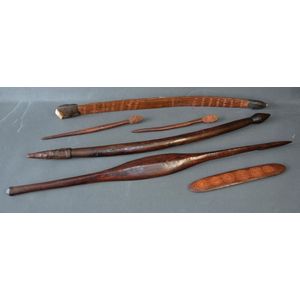
Six Aboriginal artefacts. Adze with incised decoration; spear thrower; club; carved board; & two pointing sticks. Length 60 cm (adze)

Two Aboriginal artefacts. Woomera and boomerang. Lengths 35 cm and 25 cm